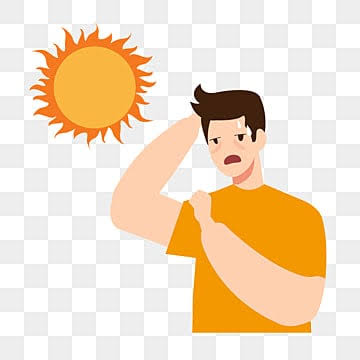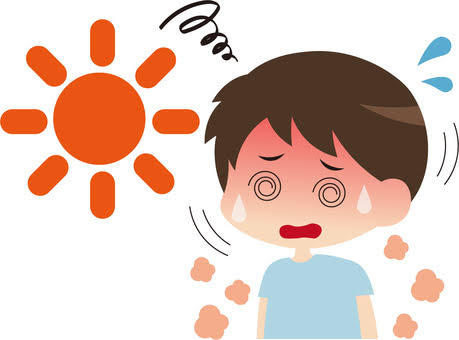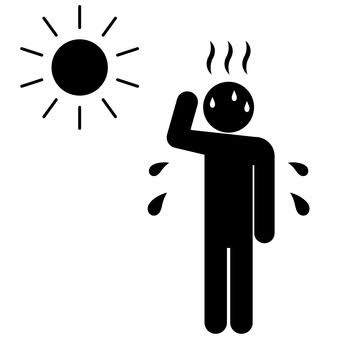Welcome to our beginner’s guide to heat stroke and how homeopathy can help treat this serious condition. When the body’s temperature regulation system fails as a result of prolonged exposure to high temperatures, heat stroke happens, which is a medical emergency that has the potential to endanger a person’s life.
We’ll go over the definition, stages, causes, risk factors, signs and symptoms of heat stroke, as well as general management and prevention, in this blog post. In addition, we will investigate the significance of homeopathy in the management of heat stroke and overall health.

What is Heat Stroke?
A severe illness brought on by heat, heat stroke is also known as sunstroke. It can happen to anyone. It occurs when prolonged exposure to high temperatures and high humidity overwhelms the body’s mechanisms for controlling temperature. The body cools itself down in most situations through sweating and other mechanisms. However, these mechanisms fail in cases of heat stroke, resulting in a rapid rise in body temperature.
The Stages of Heat Stroke
There are typically three distinct stages of heat stroke:
1. Heat Cramps: Muscle cramps, pain, or spasms are the first sign of heat-related illness. The body’s first sign of heat-related stress is typically this.
2. Heat Exhaustion: At this point, symptoms like heavy sweating, weakness, dizziness, nausea, and a rapid pulse may become more severe. Heat exhaustion can progress to heat stroke if not treated promptly.
3. Heat Stroke: This is the most serious and potentially fatal stage of heat-related illness in which the body’s core temperature rises above 104 degrees Fahrenheit (40 degrees Celsius).
If not treated immediately, heat stroke can result in organ damage, unconsciousness, and even death.
Common Causes of Heat Stroke
There are a number of potential causes of heat stroke, including:
1. Hot Weather: Being in high temperatures and high humidity for a long time, especially during heatwaves.
2. Physical Exertion: Without adequate hydration and rest, engaging in strenuous activities in the heat can raise the risk of heat stroke.
3. Dehydration: The body’s inability to effectively cool itself can be hampered by not drinking enough fluids.
4. Inadequate Clothing: Heat stroke can be exacerbated by wearing clothing that does not provide adequate ventilation or sun protection.
5. Age: Heat stroke is more common in people over the age of 65 and in those with chronic medical conditions.
6. Medications: Some drugs can make it harder for the body to regulate temperature, making people more likely to get heat stroke.
Who is at Risk for Heat Stroke?
Your vulnerability to heat stroke can be increased by a number of factors, including:
1. Age: Young children, the elderly, and infants are more likely to suffer from heat stroke.
2. Chronic Conditions: People with diabetes, heart, lung, or kidney diseases, and other chronic conditions are at greater risk.
3. Dehydration: Your risk of heat stroke can increase if you don’t drink enough water.
4. Consumption of an Excessive Amount of Alcohol: Drinking alcohol can dehydrate the body, making it more difficult to regulate temperature.
5. Excessive Exercise: In hot weather, intense physical activity can strain the body to its limits.
6. High Temperatures: Certain occupations or settings that are frequently subjected to high temperatures may increase the risk.
The Signs and Symptoms of Heat Stroke
Being aware of the signs and symptoms of heat stroke is essential because early detection can save a person’s life. Some typical indicators are:
1. High Temperature: A body temperature of 104°F (40°C) or higher is considered to be high.
2. Confusion or Agitation: Heat stroke patients frequently experience mental confusion and disorientation.
3. Flushed Skin: The failure of sweat mechanisms causes the skin to become hot and red, but it is frequently still dry to the touch.
4. Rapid Pulse: A common symptom of heat stroke is an elevated heart rate.
5. Headache: People who have heat stroke frequently complain of severe headaches.
6. Nausea and Vomiting: Nausea and vomiting are common gastrointestinal symptoms.
7. Muscle Cramps: In the early stages of heat-related illnesses, muscle cramps and weakness may occur.
8. Consciousness Loss: In severe cases, heat stroke can result in fainting or even coma.
Immediate Actions for Heat Stroke
It is essential to act quickly if you suspect someone is suffering from heat stroke:
1. Call for Help: Call the emergency number or get medical help right away.
2. Move to a Cooler Location: Get the person out of the heat and into a cooling environment or, at the very least, a shaded area.
3. Cool the Body: Applying cold packs or submerging the patient in ice water are two options for lowering the body temperature.
4. Rehydrate: Give the person cool, non-alcoholic, and caffeine-free fluids if they are conscious and able to swallow.
5. Remove Excess Clothing: To make the person as comfortable as possible, take off any clothing that is not necessary.
6. Monitor Vital Signs: Until medical personnel arrive, continuously monitor their temperature, pulse, and breathing.
Protecting Yourself from Heat Stroke
It is essential to avoid heat stroke, and you can protect yourself and others from it by taking the following precautions:
1. Hydration: Drink a lot of water to stay hydrated, especially in hot weather. Fresh fruits, electrolyte-rich beverages, and water all contribute to maintaining hydration.
2. Dress Appropriately: To protect yourself from the sun, wear light, loose-fitting clothing and a wide-brimmed hat.
3. Limit What You Do Outside: When the temperature is extremely high, spend as little time as possible outside, especially during the heat’s peak hours.
4. Use Sunscreen: To prevent sunburn, apply sunscreen with a high SPF.
5. Take Breaks: If you have to be outside, take frequent breaks in the shade and don’t do anything strenuous in the hottest parts of the day.
6. Know your Limits: Listen to your body and don’t push yourself too far in hot weather.
The Role of Homeopathy in Treating Heat Stroke
When it comes to managing heat stroke, homeopathy, a natural and holistic approach to medicine, can be used in conjunction with conventional treatments. Homeopathic treatments are well-known for their gentle approach to healing and low risk of side effects, which come from natural substances. Homeopathy can help treat heat stroke in the following ways:
1. Rescue Remedy: Arnica Montana, one of Rescue Remedy’s components, is well-known for its ability to treat heat stroke. It can assist in lessening shock, easing pain, and calming the individual.
2. Aconite: Aconite can be used to support the patient and reduce fear and restlessness when symptoms appear suddenly.
3. Belladonna: If there’s a high fever, redness of the face, and dilated pupils, Belladonna may be prescribed to alleviate these symptoms. Suitable for sunstroke with red skin, throbbing head, and vertigo.
5.Lachesis: Lachesis can be an effective treatment for delirium or unconsciousness with a flushed face.
6. Veratrum Album: When severe dehydration is accompanied by forehead cold sweat, Veratrum Album can assist in restoring equilibrium.
7. Glonoinum: Effective for heat stroke with head heat, sun headaches, and sensitivity to sun-rays.
8. Gelsemium: Used for dizziness, drowsiness, and dullness associated with heat stroke.
9. Amyl Nitrosum: Relieves rush of blood to the face, skin heat, and palpitations during heat stroke.
10. Natrum Muriaticum: Treats heat stroke victims’ blinding headaches and congestion.
It is essential to keep in mind that a trained homeopathic practitioner should administer the homeopathic treatment. Homeopathy can be a useful addition to conventional medical care because it aids in relieving symptoms and bolsters the body’s inherent capacity for healing.
Dietary Tips for Heat Stroke Recovery
Your diet plays a crucial role in recovering from heat stroke and preventing its recurrence, in addition to homeopathic remedies and conventional medical treatment. Consider the following foods and dietary guidelines:
1. Hydration: Drink plenty of water, herbal teas, and electrolyte-rich drinks to stay hydrated. Electrolytes can be found naturally in abundance in coconut water.
2. Fruits: Include watermelon, orange, and strawberry in your diet because they are high in water and can help your body rehydrate.
3. Leafy Greens: Leafy greens like spinach and kale are full of vitamins and minerals that can help you recover.
4. Yogurt: Yogurt with a lot of probiotics can help you digest and get your gut back into balance, which is often lost when you get heat stroke.
5. Lean Proteins: To help your muscles recover, eat lean proteins like chicken, fish, and tofu.
6. Herbal Teas: Drinking calming herbal teas like chamomile or peppermint can help you relax and get better.

Conclusion: Take Cover from the Sun!
A heat stroke is a serious medical emergency that needs to be treated right away. To ensure your safety and the well-being of those around you, it is essential to recognize the symptoms and take preventative measures.
Homeopathy can help with heat stroke treatment, but it should always be used in conjunction with traditional medicine. Dress appropriately, drink enough water, and be aware of the weather, especially during the hot summer months. You can safeguard yourself and those you care about from the dangers of heat stroke and ensure a safer and healthier future by adhering to the recommendations in this beginner’s guide.
Keep in mind that if you have any suspicions that a person is experiencing heat stroke, it is absolutely necessary to act quickly and seek professional medical assistance to ensure the person’s safety and well-being.
Reach out to us for a Consultation
For any queries, reach out to us at contact@homeopathic.ai
This blog is for information purposes. It’s crucial to note that while homeopathy is a centuries-old practice with many adherents worldwide, always consult a qualified homeopath or medical professional before initiating any treatment.





